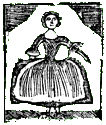 Yesterday I took a brief look at the story of one Massachusetts woman casting a vote in a town meeting in 1756. The better documented example of American women voting long before the organized suffrage movement comes from early federal New Jersey.
Yesterday I took a brief look at the story of one Massachusetts woman casting a vote in a town meeting in 1756. The better documented example of American women voting long before the organized suffrage movement comes from early federal New Jersey.When New Jersey Patriots wrote a constitution for their newly independent state in 1776, it did not require voters to be male. It required them only to head households and own a certain amount of property. The result was that there was no rule against wealthy, unmarried women voting. (If they had husbands, then the law presumed he headed the household, and each household was ideally supposed to have only one vote.)
Was that limited vote for women simply an oversight? If so, state officials soon realized what their constitution said. New Jersey’s election law of 1790 referred to a voter as “he or she.”
In the following years each party accused the other of bringing “petticoat electors” to the polls, which suggests that New Jerseyans recognized women had the right to vote but still looked askance at them actually exercising that right. Were those complaints well founded? Did custom outweigh the law? In sum, how often did New Jersey women really vote?
The late Piney Creek blog pointed me to a 1992 paper on the topic: “‘The Petticoat Electors’: Women’s Suffrage in New Jersey, 1776-1807,” by Judith Apter Klinghoffer and Lois Elkis, published in the Journal of the American Republic. It assembles a lot of evidence on the question.
New Jersey politicians seemed to agree that in the 1790s there could be up to 10,000 New Jersey women eligible to vote. Reports of actual voting tended to estimate the female electors at only a few dozen per polling place, even in larger towns, with no more than 150 statewide.
A Republican newspaper called the Newark Centinel of Freedom said that at least 75 women voted in Elizabethtown in 1797, and complained again about female Federalists in 1798 and 1800. According to the paper, the opposing party
so ingratiated themselves in the esteem of the Federal ladies of Elizabeth-town, and in the lower part of the state, as to induce them (as it is said) to resolve on turning out to support the Federal ticket.In fact, the state’s Federalist newspaper made no special claims or appeals to women before the election.
Furthermore, in 1800 the Stony Hill Republican banquet included this toast: “The fair daughters of Columbia, those who voted in behalf of Jefferson and Burr in Particular.” And at Bloomfield one party toast was: “the Republican fair; May their patriotic conduct in the late elections add an irresistible zest to their charms; and raise the female character in the estimation of every friend to his country.”
In 1801 Joseph Bloomfield became the state’s first Republican governor; he went to the polls with “that part of his female household entitled to vote.” So although the Republicans complained about Federalist female voters, they were proud of their own.
Occasionally female voting eligibility led to controversy. In 1802 an election in Hunterdon was decided by a single vote, and one of the (Federalist) voters was a married woman. But she had been separated from her husband for several years, and paid taxes on her own. But she paid those taxes under her married name—so was she eligible? Another argument arose over a formerly enslaved black woman—was she entitled to vote?
TOMORROW: The controversies come to a head in 1804-1807.
This is FASCINATING!! I had no idea that women voted this early in our history. Can't wait to read the continued post. Thank you.
ReplyDeleteDonna